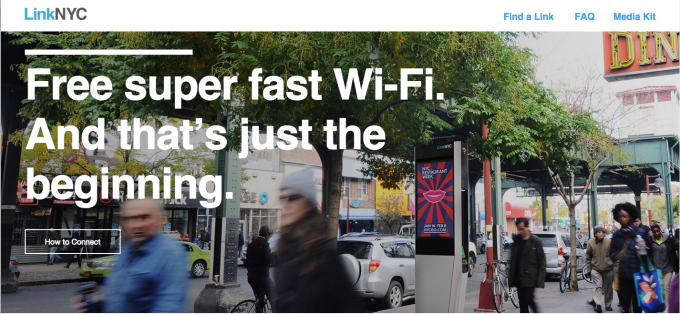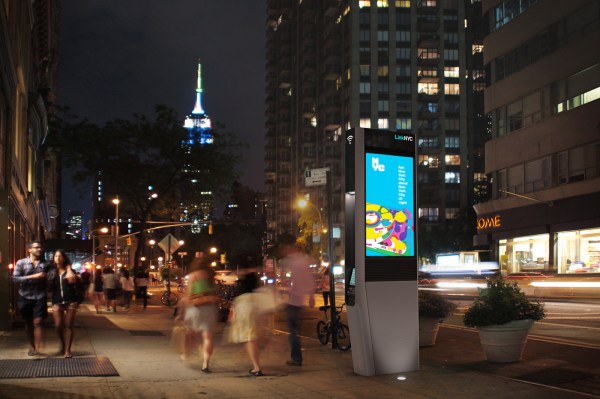The plan to turn unused NYC phonebooths into free digital hubs for local neighborhoods continues as Mayor Bill DeBlasio announced the second phase of the city’s LinkNYC program — with the unveiling of new, slightly generic tablets at the city’s newly installed hotspots.
LinkNYC demonstrated the android-powered tablet for the press yesterday, taking advantage of a “Link” structure at a nondescript intersection near New York’s Gramercy neighborhood. The demo was pretty short (and our man on the scene was stuck behind a bunch of taller writers), but it was enough to show that yep, you can make phone calls (through a service provided by Vonage).
The tablets look like generic tablets, with a basic, straightforward interface. They’re positioned on the side of the Link structures, so you have to be comfortable making your call from what is essentially the middle of the sidewalk — you can plug in your own headphones for a little more privacy.
The tablets do more than just allow folks to make free calls — the city will also be rolling out selected apps, features and services.
Right now the tablets are installed in the 15 hotspots that are actually live – all placed along a pretty uninspired stretch of Third Avenue in Manhattan.
Eventually the goal will be to have the 7,500 kiosks bringing gigabit speed, encrypted Wi-Fi — and free phone calls to anyone in the U.S. (who uses the phone to talk to people anymore?), digital mapping services, apps, and Internet browsing via tablets — to the five boroughs over the next several years.
By July the LinkNYC program will have connected the first 510 installations to select areas in Manhattan, the South Bronx, Queens, Brooklyn and Staten Island. After four years that number will jump to 4,550 — with all locations outside of Manhattan getting gigabit speed Internet.
In addition to all of the telecommunications features, there’re some features to the LinkNYC kiosks that are — if not distinctly New York — inspired by the city surrounding them.
The consortium of companies behind the project touts that each kiosk can withstand extreme heat and cold, rain, snow and flooding, earthquakes, vandalism and theft (so, basically the conditions of the city throughout this winter). Niftily, sensors in the devices will also be used to understand how the environment is effecting the structures.

We first wrote about the mayor’s plan when it was announced in 2014 and though much of the story remains the same, some of the players have changed.
Interestingly, since the program was announced of the major players that comprises the CityBridge consortium rolling out the project was acquired by the world’s second most valuable company — Alphabet.
Intersection, the group that handles design and implementation of the project is the cornerstone of Alphabet’s Sidewalk Labs division.
“LinkNYC is just the beginning of what’s possible when media and technology work together to bring digital experiences into physical space,” said Intersection’s new chief executive Al Kelley in a statement announcing his assumption of the executive role at the company.
Additional partners in the Citybridge consortium include Qualcomm, CIVIQ Smartscapes, and Antenna Design, which created the physical Link kiosk.
The move is a big step forward in the development of a citywide free internet service for New York. The only question remaining is how long the tablets remain functional before they’re bricked by people downloading and watching porn.
